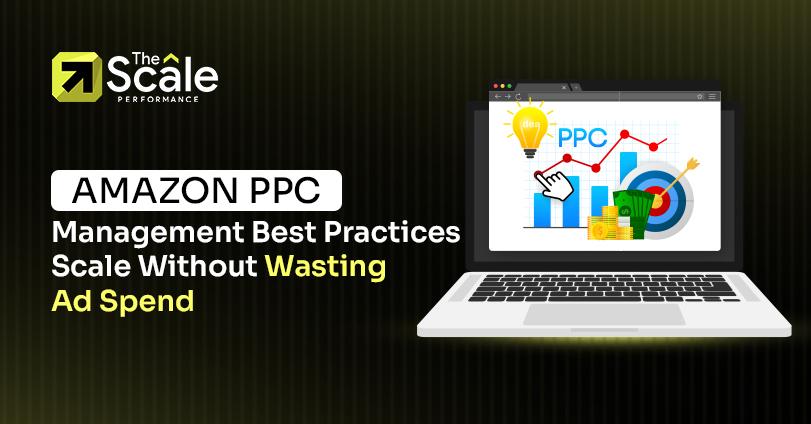
Amazon pay-per-click (PPC) advertising is one of the best marketplace growth levers, yet it can immediately erode profit margins if it’s not handled strategically. Effective Amazon PPC management has little to do with spending more and much to do with structuring campaigns, bids, and budgets to achieve repeatable performance at scale.
This handbook outlines how experienced sellers structure their PPC programs to minimize waste and deliver maximum returns. From keyword targeting to budget controls and optimization cycles, each of the following best practices is what’s winning in competitive product categories.
Understanding The Amazon PPC Ecosystem
Before diving into best practices, it’s essential to understand the architecture of Amazon PPC. Sellers can choose from three primary ad types:
Sponsored Products: Keyword-targeted advertising that directly advertises individual search results listings or product detail pages. They account for the majority of ad investments in Amazon and possess the highest level of granularity.
Sponsored Brands: Such adverts have a special title and various products and typically appear at the very top of search pages. They are ideal for establishing brand awareness and conversion.
Sponsored Display: They are aimed at off- and on-Amazon consumers, depending on their purchasing habits and interests. They are typically used for awareness-building campaigns and retargeting campaigns.
Successful PPC management in Amazon involves making proper ad-type choices based on campaign objectives, from product launches to scaling profitability.
Structuring Campaigns For Control And Clarity
A common mistake is running broad, unsegmented campaigns. High-performing sellers segment their campaigns based on match types, product types, and objectives so that they can gain insight into what’s succeeding.
Use Single-ASIN Campaign: Do not include many products in a single campaign unless their performance is similar. Single-ASIN campaigns consist of simpler performance reporting with reduced keyword overlap.
Separate By Match Type: Create distinct campaigns for exact, phrase, and broad match types. This enables tailored bidding strategies and enhanced keyword control, a crucial element of effective Amazon PPC management.
Strategic campaign structuring is the backbone of effective ad performance. It gives sellers the clarity needed to scale profitably and adjust with precision.
Keyword Research And Match Type Targeting
The quality of your keyword list shapes both visibility and cost efficiency, making keyword research and match type selection a core driver of successful Amazon PPC management.
Keyword Sourcing Best Practices: Utilize Search Term Reports in Amazon, Brand Analytics, and external sources to identify high-converting keywords. Select those with high volume-to-conversion ratios.
Match Type Strategy: Exact Match: Focus for best-performing keywords. Bid higher in this category to dominate search rankings. Phrase Match: Useful for searching for long-tail phrases.
Broad Match: Suitable for exploration but must be supplemented with a proper negative keyword list to prevent budget bleed.
Proper keyword segmentation supports smarter PPC bid management and unlocks better control over performance drivers.
Budget Allocation: Spend Smarter, Not More
Scaling without overspending depends on controlled budget distribution.
Allocate By Campaign Type
60% To Sponsored Products: These ads appear in product pages and search results and are the largest driver of high-intent conversions for most sellers.
25% To Sponsored Brands: Effective in boosting branded visibility for several ASINs. These ad placements create awareness and facilitate category leadership in the long run.
15% To Sponsored Display: Usually saved for retargeting or targeting new individuals based on purchasing behavior. The budget for this will vary based on how aggressively you’re pursuing awareness and repeat views.
Use Portfolio Budgets
Amazon allows bundling similar campaigns under one portfolio budget. This is especially useful when managing spending through product groups or when running promotions that require stricter budgeting.
Set Daily And Lifetime Limits
The use of daily and lifetime spending caps prevents unexpected spending exceedances and keeps ad spending aligned with overall fiscal goals. Start with minimal spending caps and iterate based on perceived trends in campaign performance, not guesses.
Smarter Amazon PPC Management: Bidding With Intent
Bidding directly affects how often and where your ads appear. But bidding high does not guarantee profitability. Effective PPC bid management requires adapting bids based on shopper intent, product margin, and real-time performance data.
Dynamic Bidding Options
Amazon offers three bidding strategies:
Dynamic – Down Only (recommended for efficiency): Amazon lowers your bid when it’s less likely to convert.
Dynamic – Up and Down: Raises and lowers bids based on real-time likelihood to convert.
Fixed Bids: Used when full control is required, though less common for scaling.
Adjusting Bids By Placement
Use placement reports to identify which ad positions are driving the strongest performance. When certain placements consistently convert better, increase bids specifically for those positions to prioritize visibility where it counts.
Dayparting And Seasonality
If performance fluctuates by hour or day, scheduling bid adjustments around peak traffic times improves efficiency. While Amazon does not yet natively support dayparting, manual bid adjustments or rule-based tools can replicate the effect.
Negative Keywords: Essential For Budget Efficiency
Negative keywords play a critical role in protecting the budget from waste in any structured Amazon PPC management system. Add underperforming or irrelevant search terms regularly as negatives.
- Campaign Manager provides Search Term Reports that show actual queries triggering your ads.
- Set negative exact or phrase matches for terms with high spend and low conversion.
- Audit and update your negative keyword list regularly, ideally weekly or biweekly, to keep spending focused and performance sharp.
- Depending on your structure, you can apply negative keywords at the campaign or ad group level, allowing for better control and reduced overlap.
- Use cross-negatives to prevent similar keywords from competing across campaigns, which helps preserve clean data and intentional targeting.
- Proactively exclude irrelevant close variants, especially when using broad or phrase match types that tend to trigger loosely related search terms.
Effective negative keyword hygiene ensures your budget stays aligned with actual buyer intent and campaign goals.
Optimization And Iteration: Weekly Is The Minimum
Top sellers treat Amazon PPC management as an active feedback loop, not a one-time setup.
Weekly Optimization Checklist
- Pause or reduce bids on non-performing keywords
- Add new keywords discovered through Search Term Reports
- Adjust bids based on placement data
- Update negatives
- Test new creatives (especially for Sponsored Brands)
Monthly Strategic Reviews
- Analyze ACoS (Advertising Cost of Sales) and TACoS (Total Advertising Cost of Sales)
- Identify shifts in keyword or product performance
- Review budget pacing vs. forecasted goals
- Iterate on campaign structure if necessary
Sustained Amazon PPC management depends on disciplined iteration. The more consistently you refine, the more predictably your campaigns scale.
Leveraging Amazon’s Native Tools
Amazon provides several built-in tools that streamline Amazon PPC management services:
Campaign Manager: This is your central control panel for creating campaigns, making bid adjustments, and tracking performance. It provides real-time visibility into spend, ACoS, and impressions across all ad types.
Search Term Report: Shows the actual search queries that triggered your ads, allowing you to identify high-performing keywords and filter out irrelevant traffic with negative matches.
Placement Reports: Break down ad performance by placement (top of search, product pages, etc.), helping you refine bid adjustments based on where conversions are strongest.
Budget Rules: Lets you automate budget increases or bid changes during high-traffic periods like Prime Day, ensuring campaigns remain competitive without constant manual input.
Signs Your PPC Strategy Needs A Revamp
Even experienced sellers can fall into traps. Poor Amazon PPC management often shows up in subtle performance signals that shouldn’t be ignored. Watch for these:
Rising Acos Without A Sales Lift: If your ad spend is increasing but revenue isn’t following, your targeting or bidding strategy may be inefficient.
Keyword Cannibalization Across Campaigns: Multiple campaigns targeting the same keywords can dilute performance data and drive up costs unnecessarily.
High Impression Counts But Low Click-Through Rates (CTRs): Your ads are being seen but not clicked, which could signal weak copy, irrelevant targeting, or poor product-market fit.
Uneven Budget Spend Across Ad Types: Disproportionate spending may indicate that one ad type is underperforming or that your budget allocation lacks alignment with goals.
Ad Stagnation With Repeated Keywords: No testing or change in strategy over time often leads to plateaued performance and missed growth opportunities.
If any of these appear, revisit your campaign structure, PPC bid management, and keyword segmentation immediately.
Final Thoughts
Scaling efficiently on Amazon requires more than just an increasing budget. It requires structured Amazon PPC management based on clean data, controlled bidding, and disciplined optimization.
By refining your keyword strategy, isolating ad performance, and wisely using Amazon’s built-in tools, you can protect your ad spend while unlocking meaningful growth. This is not a static process. The most successful sellers view PPC as an evolving discipline that aligns with their margin targets, inventory plans, and competitive landscape.
Make every ad dollar earn its place.




More Stories
From Zero to Job-Ready: What a Practical Digital Marketing Course Provides.
The Power of Social Media Photography for Branding
How will Generative AI Impact Website Rankings and Traffic?